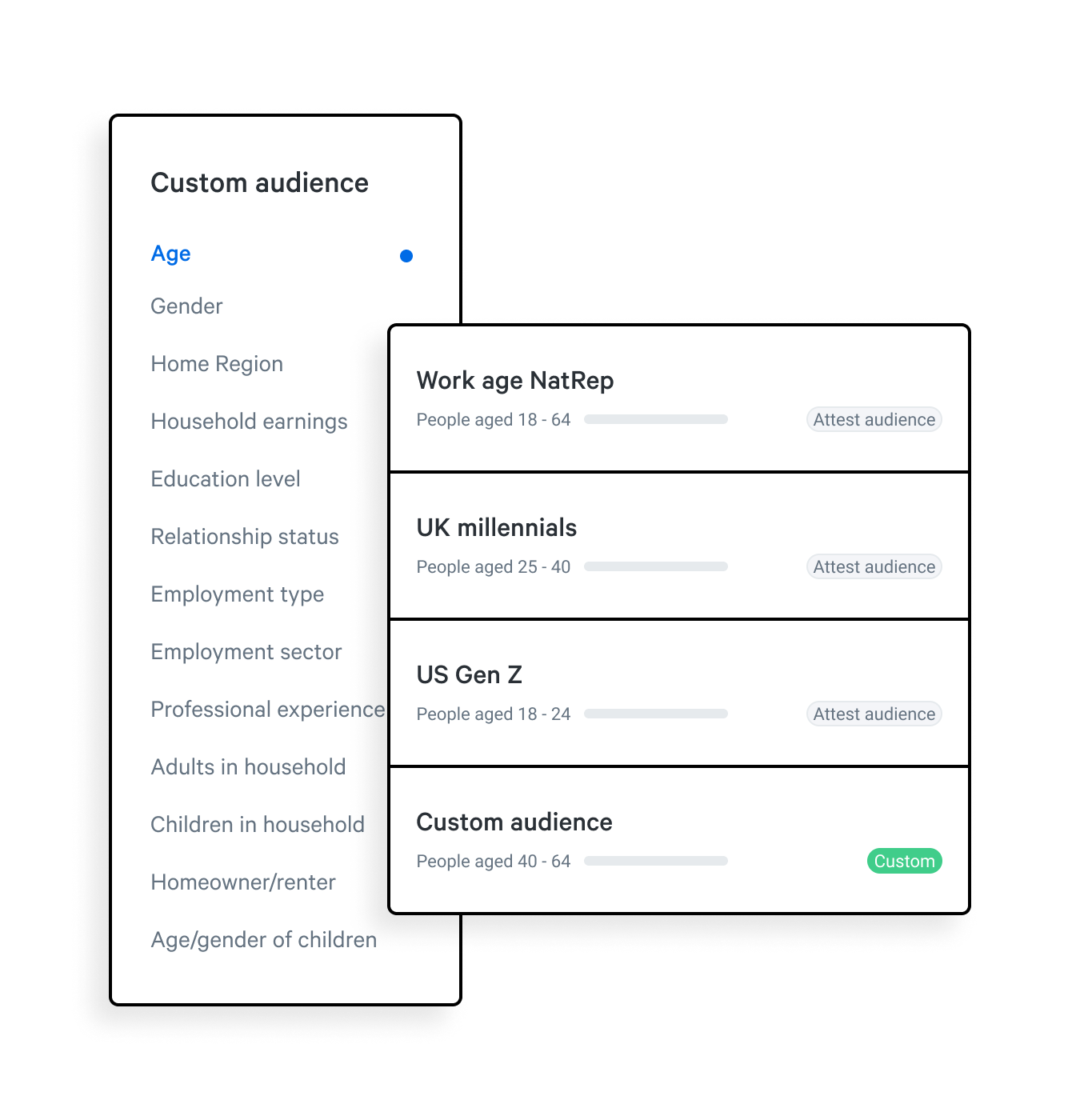13 Demographic survey questions for actionable consumer insights

Think demographic questions are an outdated and irrelevant part of market research? Think again!
While we encourage you to dive a little deeper than the who, when and where in your consumer profiling, it’s vital you get this foundation right.
Demographic survey questions help you lay the groundwork for a solid buyer persona or customer profile. It makes it easier to segment your target audience, hence making it easier to target them later on.

In this article, we’ll advocate for why you should be conducting more demographic surveys and we’ll give you some examples of demographic questions you could ask.
Here’s a sneak peek:
- What gender do you identify as?
- Where do you live?
- How would you describe your ethnicity?
- What’s your main source of income?
- How much do you make on average, on a monthly basis?
- How much does your entire household make on a monthly basis?
- What’s your highest degree or education completed?
- What field did you study in?
- What religion/faith/belief do you have?
- What is your current employment status?
- Who do you live with? Tick all the boxes that apply
- What’s your marital status?
- How would you describe your household?

Skip the demographic questions with Attest’s filters
You have access to built-in demographic filters with Attest, so you don’t even have to think about adding many of these demographic questions to your survey.
See how Attest worksWhy ask demographic survey questions?
Including demographic questions in your survey is a good way to ease survey takers into the research. You don’t have to ask respondents difficult questions right off the bat: first, get to know each other with some simple questions that don’t require too much thought.
When they’ve gotten familiar with the format and how the survey works, they’ll feel more comfortable answering more complicated questions.
Asking demographic questions will also give you more background on your target audience.
Data on demographics allows for more specific targeting. For example, you can’t segment people in ads based on their deepest darkest fears (yet) but you can segment them based on income brackets.
Demographic questions also provide context to other data that might be harder to interpret. If you recognize patterns in psychographic data, see if you can group it based on demographic data.
This might make it easier to analyze your data and, even better, make it easier to take action based on it.
The benefits of demographic survey questions
There are more advantages to asking demographic questions than you might think. Let’s look at what you’ll get out of enriching your survey with some demographic questions.

Targeted marketing
If you want to start working with targeted ads, demographic data is the first thing you’ll need. There’s no point in crafting a beautiful ad and on-point message, when you’re showing it to people in the wrong place.
By asking demographic questions you make sure you present your ads to the right people, not only maximizing results, but also avoiding unnecessary costs of showing ads to the wrong audience.
Entering a new market?
Find out how consumers in that market feel about your product, service or brand with our top market analysis tools.
More accurate predictions
Using demographic data, you can get a better idea of what products are going to be in demand when and where. You’ll be better able to identify patterns and optimize your logistical processes and marketing efforts.
Act—don’t just react
Often a deep dive into demographic data can explain certain changes in demand. Remember that people get older, move away or start new jobs.
This might trigger changes in their spending. Knowing this, you can anticipate and act instead of reacting.
Optimize costs and logistics
Acting on demographic insights helps you decide exactly where and when to locate products and services.
This will ensure that there are never empty shelves and you won’t have to throw out unsold products.
13 demographic survey questions to include in your next survey
If you’re keen on building buyer personas that are highly specific and effective, but not sure what questions will get you there, we’re here to help. We won’t state the obvious, but show you some demographic survey questions that will give you actionable data.
Gender
For certain products or services, the respondent’s gender is certainly relevant. Remember this though: don’t ask about gender when it really isn’t relevant and you don’t plan on segmenting based on it anyway. Especially if you’re only planning on including the options Male and Female.
Our suggestion? Use gender-related questions only if necessary, and if you do use them, make them as inclusive as possible: leave a blank option where respondents can describe their identities in their own words, and an option ‘prefer not to say’.
1. What gender do you identify as?
- Genderqueer
- Non-binary
- Cisgender woman
- Cisgender man
- Transgender man
- Transgender woman
- Prefer to self describe: _______________
- Prefer not to say
Don’t be afraid to ask about gender, but make sure you have a good reason for doing it. Added points if you explain why you’re asking.

If you follow up with questions about partners or sexual orientation, make sure to be as inclusive there as well. There’s more to it than straight or gay.
If you have to ask, make the answers specific. If you do, you’ll actually make your results more relevant, and your bosses and peers will thank you!
Location
Location, location, location. Yes, there can be more than one location to think about.
Someone might live in a small town, but work in the big city, where they spend most of their time and money.
So in your questions about location, make sure to get specific about where people are throughout the day, to keep your targeting as relevant as possible.
2. Where do you live?
You could either provide a list of options for this question—cities, regions etc.—or ask respondents to enter their location into a text field. Be careful with text fields though as you may not always get consistent responses. You also shouldn’t ask for ZIP or post codes.
Ethnicity
Demographic information that includes ethnicity is often more valuable, because you can get a lot of information on culture, attitudes and behaviors from it.
You should approach ethnicity questions with the respect they deserve, so make sure that your list of ethnicities to choose from is complete.
Ethnicity can explain some differences in behavior between survey respondents. Here’s how we’d ask about it.
You can use two separate questions: what’s your background, and how do you identify. We recommend this format to cover it all:
3. How would you describe your ethnicity?
- White
- Black
- Asian
- Amerindian/Alaska native
- Native Hawaiian/Pacific Islander
- Mixed ethnicity, namely ______
- Other:_____
Income
Someone’s income can reveal significant details about their spending, and can inform your strategy with great insight.
So how would we ask about a participant’s income? The easiest way to segment people based on income, is using a multiple choice format.

If you want to make it even more specific, ask where the money’s coming from. For instance, knowing most of your consumers are freelancers, can explain a lot about dips in spending. Here goes:
4. What’s your main source of income?
- Freelance work
- Own business
- Employment
- Pension
- Dividend income
- Rental income
- Other:_____
5. How much do you earn on average, on a monthly basis, before taxes?
Use income brackets that are relevant in your country. We recommend working with 5-6 brackets—for example:
- $0-9,999
- $10,000-19,999
- $20,000-39,000
- $40,000-59,999
- $60,000-79,000
- $80,000+
Sometimes it’s not just the respondent’s individual income that matters: it’s their annual household income that’s more relevant.
6. How much does your entire household make on a monthly basis before taxes?
Include household income brackets that are relevant in your market, plus:
- I don’t know/I’m not sure
- Prefer not to say
Education level
Demographic information about education can go beyond asking someone if they have a diploma and on what level.

What if you would find out that people who studied medicine spend way more on your products than law and marketing students? You’d probably put your billboards a little closer to hospitals, wouldn’t you?
Here’s how we’d make a demographic survey question on education more relevant
7. What’s your highest degree or education completed?
- Early Childhood Education
- Primary Education
- Lower Secondary Education
- Upper Secondary Education
- Post-Secondary Non-Tertiary Education
- Short-Cycle Tertiary Education
- Bachelor’s or Equivalent Level
- Master’s or Equivalent Level
If it makes sense from their first answer, follow up with:
8. What field did you study in?
- Art
- Business Administration
- Chemistry
- Economics
- Education
- Engineering
- Etc.
Religion, faith and beliefs
Religion can be a factor in how people make decisions about consumption and spending, so it’s an important one to remember in your demographic information—but only when it’s done sensitively and relevantly.
In some countries you’re not allowed to ask about people’s religion—for instance in France or Germany—so make sure you check the laws of the country in which you’re gathering responses.
It’s again crucial that you know how to ask about it, to get those important cultural details—while also maintaining a great relationship with consumers.
9. What religion/faith/belief, if any, do you have?
- Bahá’í
- Buddhism
- Christianity
- Confucianism
- Druze
- Gnosticism
- Hinduism
- Islam
- Jainism
- Judaism
- Rastafarianism
- Shinto
- Sikhism
- Zoroastrianism
- Traditional African Religions
- African Diaspora Religions
- Indigenous American Religions
- No religion
- Prefer not to say
Occupation and employment status
Someone’s job title or current employment status can explain a lot about their behaviors as a consumer.
It reveals who they hang out with a lot, what content they are exposed to and what some of their interests are.

Here’s how you ask about a participant’s employment status.
10. What is your current employment status?
- Worker
- Employee
- Self-employed
- Business owner
- Retired
- Job-searching
- Not working, not searching
Family structure and marital status
Someone who shops for food, or socks, or a television, or anything, doesn’t necessarily do that for themselves. Oftentimes, there are decision makers in a household, influencers, and the ones actually purchasing products. And often, that’s not the same person.
Ask people about their marital status and how many children to find out how their household income is divided.
11. Who do you live with? Select all that apply.
- I live alone
- I live with friends
- I live in a shared building with students
- I live with my partner(s)
- I live with my parents
- I live with my children
12. What’s your marital status?
- Single
- Married
- Widowed
- Divorced
- Separate
- Registered partnership
13. How would you describe your household?
- One-person household
- Couple without children
- Couple and child/children
- Single-parent household
- Household including extended family
- Other

Best practices for demographic surveys
Here’s some more etiquette tips on including demographic questions in your survey.
Throw assumptions out of the window
Use demographic survey questions to eliminate any assumptions and get a more accurate picture of your customers.
Get weirdly specific
Age is just a number. Some people get married at 21, some at 55, some never. Always ask follow-up questions to paint a better picture of your customers.
Be respectful and inclusive
Asking consumers about their income, religion or family background needs to be done sensitively.
Keep your questions neutral at least, but better yet: respectful and inclusive.
Make sure follow-ups are logical
This is not a Christmas dinner with your family—respondents don’t expect to be asked five times over what their marital status is.
So when asking follow-up questions, make sure there are logical jumps in the sequence of questions people are asked to avoid any confusion or superfluous data—if you make your research too long, you’ll annoy respondents and your survey responses might become unreliable.

If you’re trying to find out where your brand stands among your customer segment(s), follow up with some brand tracking! We’ve compiled the essential questions brand managers should be asking.
Send your consumer profiling survey and get results in hours
Mix and match our demographic survey question examples to create a survey that’s just right for you.
The more you know about your target audience, the better: but make sure to get the basics right, first. With market research from Attest, collecting and analyzing demographic information is a breeze.
Collecting demographic information and analyzing them in the same place has never been easier: get to know your current and future customers even better using our tools for consumer profiling.
Use a survey platform with 17 built-in demographic filters
No need to ask all of these demographic questions with Attest—our platform comes with 17 pre-set demographic filters, to let you get on with gathering your insights.
Start gathering insights today!FAQs
A demographic survey is used to collect demographic information for market research. It asks questions about things like age, income, occupation, gender, religion and ethnicity, in order to fully understand your target consumers’ behaviors and attitudes. Send your first survey with Attest’s customer profiling template.
A demographic survey question can ask anything from household income to marital status. The basics are often age, gender and location, supplemented with religion, ethnicity, occupation and income. Uncover insights into your key demographics with our customer profiling template.
The easiest way to do demographic research is by an online survey. Using a tool like Attest is the quickest way to gather demographic information and analyze survey results. Get started with our customer profiling survey templates today!
And finally, some quick (but important) info on making sure your demographic research is compliant…
Considerations for sensitive/special category data
It’s important to consider that, in many jurisdictions, some categories of data are considered to be particularly sensitive, special category data for the purposes of data protection legislation, so extra caution should be taken when collecting or processing the data.
Amongst other things, this includes asking questions related to a respondent’s racial or ethnic origin, religious or philosophical beliefs, sexual orientation, etc. When asking demographic questions, you should:
1. Always get comfortable that you’re acting in compliance with the legislation applicable in the relevant jurisdiction; and
2. Exercise extra caution if you are collecting any sensitive/special category data.
You should seek your own advice if you’re unsure. Some things we’d recommend are:
1. Linking to your company’s privacy policy, including a message to confirm that the survey will include optional questions relating to X, Y and give an explanation as to what that data will be used for;
2. Making sure the questions are optional and can be skipped; and
3. Obtaining the respondent’s consent to process the data, by including wording like “If you don’t consent to your data being processed, please skip question(s) X and Y. In responding to the question(s), you are confirming that you consent to the processing of data relating to your X, Y, Z [Link to your privacy policy]”.
Tell us what you think of this article by leaving a comment on LinkedIn.
Or share it on:
